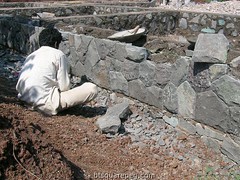 I’ve always advocated that small structures should be built using load- bearing walls because, to my mind, reinforced concrete cement (RCC) is not merely a waste of high-energy material but is, most of the time, very badly cast as well.
I’ve always advocated that small structures should be built using load- bearing walls because, to my mind, reinforced concrete cement (RCC) is not merely a waste of high-energy material but is, most of the time, very badly cast as well.
For the plinth, I usually specify random rubble – it is cheap, stable and highly effective as a detterent to dampness. In the Pune project, I decided to semi-dress the stone. Although it costs a bit more, it does look so much better. The guys who specialise in this work are plentiful in Pune and much better at what they do than the ones I’ve come across elsewhere.
They were a bit surprised, though, that I wanted it random and not shaped into rectangular blocks. It seems there are only two varieties of people these days – those who use the stone undressed and those who want ashlar. The path I chose is, apparently, the one least trod.




